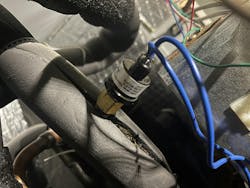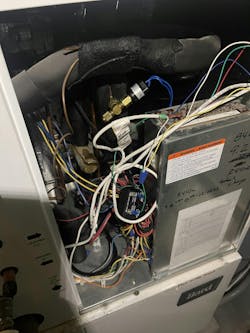Geothermal Rescue - Owner Plagued by Intermittent, Inconsistent Operation
I seem to run into two types of system rescue projects. We'll call them "fun" and "layered."
The “fun” rescues involve the careful study of what isn’t working in a system, developing and implementing an insightful solution, and seeing a dramatic improvement in performance and comfort. It is fun to identify the culprit or bottleneck that is hindering successful operation and then doing the necessary work (like re-piping, re-configuring, re-controlling, and swapping out of equipment) to get robust and reliable performance.
The “layered” rescues, such as the one I'm about to describe, involve peeling back layer after layer of issues and frustration and hearsay and homeowner perception to ultimately get to the multiple causes—small though they may be—that have resulted in a poorly performing system. These layered rescues are often defined by intermittency–things work and then they don’t and then they do.
The dynamic interaction between equipment and these small causes can be challenging to analyze and very confusing for the homeowner and the contractor.
The only way forward in these situations is careful documentation across all of the equipment, carefully noting all homeowner perceptions (these can be completely contradictory but end up making sense in the end once the dynamic interactions between equipment and the house are understood) and a step-by-step elimination of variables and sources of intermittency. The homeowner’s impulse to rip everything out and start over has to be managed calmly so that good equipment that is correctly sized doesn’t get unnecessarily tossed out and replaced.
Geothermal Systems Should Be Rock Solid
This HVAC system had multiple horizontal closed geothermal loops connected to four water-to-air heat pumps by two pressure sensing circulators and motorized ball valves. Two of the heat pumps were split systems with separate air and compressor sections. Each heat pump had its own internet-capable thermostat. Systems like this are installed across the globe on a daily basis and are rock solid in their performance and longevity.
The homeowner wanted a reliable, long lasting system, so they went with geothermal. Unfortunately in this installation, they got frustration and intermittent operation. The homeowner’s experience was that the system was not consistent—it never seemed to reach the heating or cooling setpoints, the house was always too hot or too cold. They wanted to blame the geothermal concept or the equipment sizing or the installation, but we knew that there must be other issues lurking to cause the intermittent operation plaguing this system.
Was It Correctly Sized?
Our first task was to understand how the homeowner used the home and what his expectations were in terms of heating and cooling setpoints. Did the equipment size meet the Manual J heating and cooling loads? Was the ductwork adequate to connect the heat pump coils with the air flow into the living spaces? Did the architect sabotage success by changing floor register sizes or design to severely alter air flow and heating and cooling capacity? Were the two pressure sensing circulators and connecting piping adequate for the flow needed for all of the heat pumps?
Our initial study showed that the four heat pumps were more than adequate for their heating and cooling loads and that the geo field was large enough and balanced (between heating and cooling inputs) for years of continuous operation. Nothing jumped out as an obvious bottleneck or culprit. What could cause a well designed and installed system like this to fail so miserably in delivering reliable heating and cooling?
Many Variables in Play
Our next task was to study the system—now that we understood that the system sizing and infrastructure were more than adequate, we could dig into the various reports of intermittent operation and identify how and where they happened. Because many variables are in play at once, intermittent operation can be challenging to resolve. Additionally, the unforeseen and unintended interaction of the small issues often results in the poor performance the homeowner was complaining about.
It took a while, but we gradually came to realize that there were issues with control signals getting from the four thermostats to the four heat pumps, that there were issues within each of the heat pumps, and that there were issues depending on how and when each heat pump turned on. Now we could resolve each of these issues and ideally remove the intermittent operation of the HVAC system.
Damaged Wires from an Angry Electrician!
The homeowner had complained that different heat pumps were sometimes not turning on and some rooms got too hot during cooling season and too cold during heating operation. Additionally, it appeared that the humidifiers were not working correctly and humidity levels were too low in the winter.
We started testing thermostat operation and realized that our call for heating or cooling wasn’t always getting through to the heat pumps. While examining the control wiring, we realized that some sections of the control wiring had wire staples smashed flush with the side of the wooden joists! The electrician had sunk those wire staples with a vengeance—it must have been one angry electrician!
We noted fluctuating and low voltages on various control wires—for example, the reversing valve wires at several heat pumps were getting 24 volts, then 0 volts, then 12 volts. No wonder the heat pumps got completely confused and ended up faulting out because they kept getting intermittent calls for heating and cooling modes. To the homeowner this manifested as no heating and cooling and led to his perception that the entire system was flawed. To us, we realized that the angry electrician should have taken the day off (or left the jobsite) instead of smashing wire staples which led to compromising so many conductors.
Testing a Theory
Once we understood this control wire situation, we ran temporary wires from thermostats to heat pumps to test our theory. Suddenly mode issues disappeared and heat pumps stayed on until the heat or cool call was satisfied. That was huge progress and gave the homeowner confidence that we knew what we were doing. Ultimately, the homeowner opted to not smash open the walls to replace controls wires; we noted that each thermostat location had a spare wire and we were able to steal enough conductors from spare wires to get heating and cooling to work at all four heat pumps. Unfortunately we didn’t have enough conductors to get humidification signals to work in two zones.
Heat Pump Issues
While we were working on the control wire issue, we started to look at the issues inside each of the heat pumps. Geothermal water-to-air units are great for plumbers as they have factory sealed refrigerant circuits—just hook up the water and power and you had heating and cooling. This also lent clarity to any issues on the refrigerant side; if there were any issues it was from the factory, not from guys in the field doing a bad or inadequate refrigerant installation.
We noted quite a few issues with these four heat pumps. There seemed to be a mix of low and high pressure error codes, low flow error codes, and a lack of heating and cooling capacity.
For the heat pumps with refrigerant pressure error codes, we confirmed that they had adequate water and air flow. Once we had confirmed this we could move to our next suspicions. Inadequate factory charge? Defective pressure switches? Leaking coils or refrigerant piping?
Heat Pump Leaks and Low Charge Issues
Though we didn’t want to (because they were factory sealed units), we put our gauges on the heat pumps so we could dive into the refrigerant side. Three of the four heat pumps had low pressure. We pulled the refrigerant charges and noted that they were low. Ultimately we found some refrigerant leaks between the separate blower and compressor sections and at one coil. We replaced the coil and corrected the refrigerant connections and recharged to factory charge.
We thought we were in the clear but we still got low and high pressure error codes! Our next step was to replace all four low pressure switches and two high pressure switches. This resolved the pressure fault codes with two of the heat pumps but we had to also replace control boards in the other two heat pumps. This resolved the pressure fault codes and the four heat pumps operated within correct refrigerant temperature and pressure parameters.
We did experience one heat pump that worked well in heating but crapped out in cooling. It seemed like a floating obstruction in the refrigerant circuit. Replacement of the TXV in that heat pump resolved that issue.
Dynamic Issues – How Well Did the Heat Pumps Play With Each Other?
Now that we had resolved the local issues within each heat pump and could get any one of the four units to correctly heat or cool based on the call from its thermostat, we could move to how the entire system operated as a whole.
By studying the dynamic interactions between the heat pumps we could better understand when and where heat pump issues cropped up.
During our testing of the start up of various combinations of heat pumps, we realized that we were seeing the unforeseen dynamic interaction of the pressure sensing circulator, each heat pump’s slow opening motorized valve, and each heat pump’s flow switch.
Because the pressure sensing pump only ramped up pressure when it saw pressure dropping—due to the motorized valve opening—it didn’t ramp up flow enough to satisfy the flow switch of the heat pump that was calling for geothermal water. The control board of the heat pump would see that as a low flow condition and make the heat pump go into fault and stop operation.
This situation only occurred during certain combinations of heat pumps. If enough heat pumps were running, then the pressure sensing circulator would already be ramped up and one heat pump could turn off and another heat pump could turn on without tripping their flow switches.
Jumped Out Flow Switches Prove Our Hypothesis
It was easy enough to jump out the flow switches and prove that the pressure sensing circulator, the four motorized valves, and the four heat pumps could all work nicely together. Once the flow switches were jumped out, heating and cooling worked as desired and the homeowner was happy with his system. We didn’t want to leave the heat pumps unprotected from a true low-flow situation, so we installed time delays on the flow switches at each heat pump. This was our way of giving each heat pump a “grace period” to give them a chance to run without faulting out so quickly as their geothermal water flow was ramping up.
Successful but Exhausting.
This rescue was exhausting as we had to convince the homeowner that the geothermal concept itself was sound, the system design and sizing were sound, and that the system could ultimately keep him comfortable in heating and cooling. But in the end, the homeowner was happy, they didn’t waste money on ripping out a perfectly good system, and we had completed another geothermal rescue.
About the Author
Brian Nelson
Brian Nelson is the co-owner of Nelson Mechanical Design, a “green” mechanical contractor serving the energy efficiency and home comfort needs of Martha's Vineyard, MA since 2004. The company designs, installs, and services just about anything to do with heating, cooling, domestic hot water, water treatment, geothermal, heat pumps, and radiant. NMD is committed to preserving the fabric of the Island it calls home. To learn more visit nmdgreen.com.









